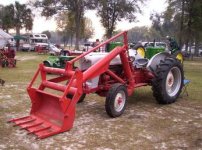Regarding the initial question: what is breakout force?....I have always thought it was the combined max force generated by using both lift and curl cylinders simultaneously when the bucket/grapple is on the ground. That is somewhat different (higher) than just curl force at front lip of the bucket.
If one were to look up the technical specs on how breakout force was measured, one wouldn't have to think about it....

. By the way, I didn't specify which cylinders were used to generate the upward force at the bucket lip.
SAE J732 is written for larger wheel and track loaders, but should also apply to skid steers and compact track loaders. Breakout force is one of the specifications defined, and here is how it is measured;
1. Loader on hard surface, transmission in neutral
2. All brakes released
3. Unit at standard operating weight, rear of loader not tied down
4. Bottom of cutting edge parallel to ground, no more than .75" above the ground
5. If tilt circuit is used, bucket hinge pin must be specified as pivot point, and lift arms should be blocked under bucked hinge pin to minimize linkage movement.
6. If lift circuit is used, pivot point should be specified as lift arm hinge pin, and front axle should be blocked to minimize tire deflection.
7. If both circuits are used, the dominating pivot point must be specified.
8. If the circuit causes the rear of the machine to leave the ground, the force required to lift the rear of the machine is the breakout force.
This is all listed in the Caterpillar Performance Handbook in the wheel loaders section. In the skid steer section, both lift and tilt breakout forces are listed separately. SCUT, CUT and even UT's often don't list which break out is published and some even fail to follow the specs exactly -- resulting in what I call "marketing numbers" that have little to do with what the machine can do.
Your comment on the lift being affected by the size of the bucket is valid, but the manufacturer should list lift and breakout for each bucket as it it part of the spec. Personally, I
only want to know how much the machine I'm on with bucket that it has attached can lift. The pivot point number fails to give me a feel for that as it can be hugely different. But, that's just me, YMMV.
jb

